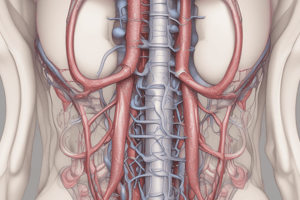Podcast
Questions and Answers
What is the main function of the tunica albuginea in the testis?
What is the main function of the tunica albuginea in the testis?
- To produce spermatozoa
- To produce testosterone
- To establish a blood-testis barrier
- To provide a dense connective tissue capsule (correct)
What is the primary function of Leydig cells in the testis?
What is the primary function of Leydig cells in the testis?
- To produce spermatozoa
- To produce testosterone (correct)
- To establish a blood-testis barrier
- To provide physical and nutritional support to germ cells
What is the approximate number of pyramidal compartments or testicular lobules in each testis?
What is the approximate number of pyramidal compartments or testicular lobules in each testis?
- 250 (correct)
- 500
- 100
- 1000
What is the main function of Sertoli cells in the testis?
What is the main function of Sertoli cells in the testis?
What is the process by which spermatogonia change to spermatozoa?
What is the process by which spermatogonia change to spermatozoa?
What is the function of the occluding junctions between adjacent Sertoli cells?
What is the function of the occluding junctions between adjacent Sertoli cells?
What type of cells are found in the interstitial connective tissue of the testis?
What type of cells are found in the interstitial connective tissue of the testis?
What is the name of the barrier established by the occluding junctions between adjacent Sertoli cells?
What is the name of the barrier established by the occluding junctions between adjacent Sertoli cells?
Flashcards
Tunica albuginea function
Tunica albuginea function
Provides a dense connective tissue capsule for the testis.
Leydig cell function
Leydig cell function
Produces testosterone in the testes.
Testicular lobules #
Testicular lobules #
Approximately 250 pyramidal compartments or lobules in each testis.
Sertoli cell function
Sertoli cell function
Signup and view all the flashcards
Spermiogenesis
Spermiogenesis
Signup and view all the flashcards
Blood-testis barrier
Blood-testis barrier
Signup and view all the flashcards
Interstitial cells
Interstitial cells
Signup and view all the flashcards
Interstitial cell types
Interstitial cell types
Signup and view all the flashcards
Germ cell support
Germ cell support
Signup and view all the flashcards
Blood-testis Barrier Junctions
Blood-testis Barrier Junctions
Signup and view all the flashcards
Study Notes
The Testis
- The testis is surrounded by a dense connective tissue capsule called the tunica albuginea.
- The tunica albuginea divides the testis into approximately 250 pyramidal compartments or testicular lobules.
- Each lobule contains:
- Connective tissue with endocrine interstitial cells (Leydig cells) that secrete testosterone.
- One to four highly convoluted seminiferous tubules where sperm production occurs.
Functions of the Testis
- Production of spermatozoa.
- Production of male sex hormones, mainly testosterone.
Germinal Epithelium
- The germinal epithelium is primarily composed of sex cells and a few supporting cells (Sertoli cells).
- The cells lie on a basement membrane surrounded by a connective tissue sheath.
Sex Cells (Spermatogenic Cells)
- Form 4-8 layers in the seminiferous tubules.
- Differentiate progressively from the base to the lumen of the seminiferous tubule.
- Cells include:
- Spermatogonia
- Primary spermatocytes
- Secondary spermatocytes
- Spermatids
- These cells change to spermatozoa through spermiogenesis.
Sertoli Cells
- Tall columnar cells with bases resting on the basement membrane.
- Apical cell membranes are highly folded and project into the lumina of the seminiferous tubules.
- Cells have pale irregular nuclei with a large nucleolus.
- Lateral cell membranes of adjacent Sertoli cells form occluding junctions, establishing a blood-testis barrier.
Functions of Sertoli Cells
- Provide physical and nutritional support to developing germ cells.
- Perform phagocytosis of cytoplasm eliminated during spermiogenesis.
- Establish a blood-testis barrier by forming zonulae occludentes between adjacent Sertoli cells.
Interstitial Connective Tissue
- Loose connective tissue containing macrophages, fibroblasts, and mast cells.
Studying That Suits You
Use AI to generate personalized quizzes and flashcards to suit your learning preferences.



